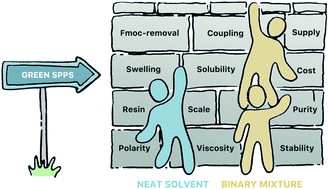Harnessing polarity and viscosity to identify green binary solvent mixtures as viable alternatives to DMF in solid-phase peptide synthesis†
Abstract
Solid-phase peptide synthesis (SPPS) enables routine synthesis of virtually any type of peptide sequence and is the preferred method for peptide synthesis in academia and the pharmaceutical industry alike. Still, SPPS typically requires significant amounts of hazardous solvents and thus suffers from a negative environmental footprint. Such drawbacks have spurred numerous initiatives for solvent substitution, reduction and recycling, and a handful solvents have recently been proposed as potential green alternatives to N,N-dimethylformamide (DMF). In this report, we recognise solvent viscosity and polarity in combination as key physicochemical parameters for SPPS and identify green binary solvent mixtures of dimethyl sulfoxide (DMSO) and 1,3-dioxolane or 2-methyl tetrahydrofuran that closely resemble DMF. In a series of reagent dissolution, resin swelling, peptide coupling and Fmoc-removal experiments we show that combining solvents offers unprecedented opportunities to predict and fine-tune the overall solvent properties for different aspects of SPPS. Lastly, the identified green binary solvent mixtures were employed for the synthesis of a range of challenging model peptides and peptide therapeutics on meaningful scale, demonstrating that binary solvent mixtures are viable green alternatives to DMF in SPPS.

- This article is part of the themed collection: 2021 Green Chemistry Hot Articles


 Please wait while we load your content...
Please wait while we load your content...